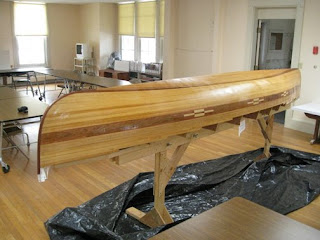C'est la vie.
Every now and again the class I teach has a "double session". We start at our usual time and have a break for lunch and continue for the rest of the afternoon. The big advantage is that save probably about an hour of class time that is usually spent moving boats and gear back and forth. The side advantage is the lunch. We either order something out or have a "pot-luck" meal. The camaraderie of a full day is really great, to be quite honest. My classes are small and they become a tightly knit group. Often, former students drop in to see what is going on.
This Saturday, we had a double session. It was a productive day in all respects. My two students who are in the process of building a Wee Lassie and Wee Lassie II canoe managed to finish stripping 1/2 of the "football" on both boats and from the feature strips most of the way to the sheer line. Considering the fact that they have been stripping for 4 class sessions, they have made a lot of progress. Here are pictures of their boats:

The student who lost his woodworking shop to fire and his friend who lost his boat in the same incident worked on the Osprey sea kayak and did a LOT of work, assembling the stems, sheer clamp and about 1/2 of the hull stripping in a day. These two students have had a large number of setbacks including the loss of tools, stems and some of the bow and stern patterns for the kayak in the fire. They were both very pleased to finally get stripping the hull and to make the progress that they did. The strip selection was made so that contrasting strips on both sides of the hull are mirrored. He plans to put detail strips on the deck, but the hull will be attractive as well. Here are some pictures of his progress:


On top of all of this woodwork, one of my students was ready to 'glass her canoe. We did this in a warm, clean room above the shop. We managed to do an instructional session for the other students to observe the set-up of our epoxy station, the draping and saturation of the cloth and the trimming of the excess cloth. We also added two layers of 'glass over the stem and stern to finish the canoe. This is probably one of my favorite parts of the class as the instructor because the student finally sees the woodwork "pop". Grain is enhanced and contrasting woods show their beauty. Here's the boat:
 It's difficult to see because of the reflection of the lights, but the bottom "football" of the canoe was started with a dark strip and goes lighter in a gradient pattern as it goes towards the keel. This student is also a quilter and she wanted to have a 9-patch built into her feature strip that was reminiscent of her quilting work. A close-up of the detail is below:
It's difficult to see because of the reflection of the lights, but the bottom "football" of the canoe was started with a dark strip and goes lighter in a gradient pattern as it goes towards the keel. This student is also a quilter and she wanted to have a 9-patch built into her feature strip that was reminiscent of her quilting work. A close-up of the detail is below:
A great day and beautiful work by my students!













2 comments:
A productive day indeed!
There's an award for you over at my blog.
You inspire amazing work in your students! Great work!
Post a Comment